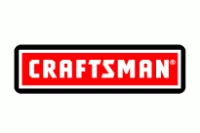Documents: Go to download!
User Manual
- Owner's manual - (English, Spanish)
- Warranty Guide - (English)
- CA Prop 65 - (English)
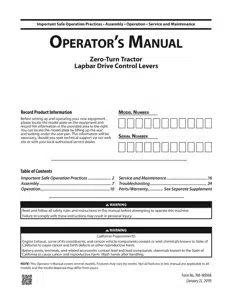
- ASSEMBLY
- OPERATION
- OPERATION
- SERVICE AND MAINTENANCE
- TROUBLESHOOTING
Table of contents
User manual Lawn Mower
ASSEMBLY
Note: This Operator’s Manual covers several models. Tractor features may vary by model. Not all features in this manual are applicable to all tractor models and the tractor depicted may differ from yours.
Note: All references in this manual to the left or right side and front or back of the tractor are from the operating position only. Exceptions, if any, will be specified.
Preparation
Manually Move the Tractor
- To engage the transmission bypass rods, pull the rod back (a) and into lower section of “J” slot. Repeat on opposite side. See Figure 1.
- After moving tractor, reverse step one to disengage the bypass rods.
- Remove the deck wash system nozzle adapter from the manual bag, store for future use.

Install Hitch (If necessary)
1. Locate Hitch (a) and install on the rear of the frame using the two hex washer screws (b) provided. See Figure 2. Note: Hitch and hex washer screws will be the hardware pack.
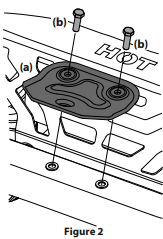
Reposition Upper Hoop (If necessary)
Upper hoop may be positioned down for shipping purposes:
- Remove the two hex washer screws (a) partially installed on the frame. See Figure 3.
- Rotate the upper hoop (b) into position. See Figure 3.
- Secure hoop in place with the hex washer screws removed in step 1. Torque the hex washer screws to 159-239 in-lbs (18-27 N-m).
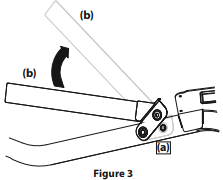
Install Operator’s Seat
Knob Adjust or Lever Adjust
1. Cut any straps securing the seat assembly to the tractor. Remove all packing material. Note: Be careful not to cut the seat wiring harness.
2. Install the seat onto the seat pan (a) using hardware provided.
a. For a Knob Adjust seat insert bolts (b) in the rear holes and lock washer (c) and knobs (d) in the front. Tighten securely. See Figure 4.
b. For a Lever Adjust seat use flange lock nuts (a) and flat washers (b). See Figure 5.

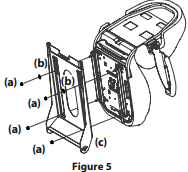
3. If necessary, securely connect the seat switch wiring harness (a) to the seat switch (b). See Figure 6. Secure excess wire away from pinch points before continuing. Note: Tractor will not operate without the seat switch wiring harness connected.
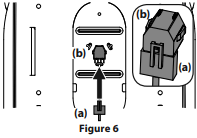
Position Lapbar Drive
Control Levers
The lapbar drive control levers can be adjusted up/down and forward/backward for the operator’s comfort. Three height positions are available and/or levers can be rotated forward or rearward using the knob.
To adjust the lapbar drive control lever height, proceed as follows:
1. Remove the two carriage screws (a) and two flange lock nuts (b) that secure the lapbar drive control lever (c) to the upper handle adjuster (d). See Figure 7. Note: The multi-tool (if equipped) can be used to make this adjustment.
2. Move the lapbar drive control lever into one of the three available heights and secure in place with the carriage screws and flange lock nuts. See Figure 7.
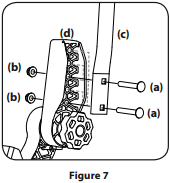
To adjust the lapbar drive control levers forward/rearward, proceed as follows:
1. Rotate the knob (a) counterclockwise to loosen the knob (a). See Figure 8.
2. Lift and rotate the lapbar drive control lever into the desired position.
3. Rotate the knob clockwise to secure the lapbar drive control lever into position. See Figure 8.
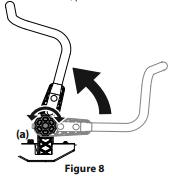
Lower Deck Discharge Chute Deflector
42” Deck Models
1. Remove the keys attached with a zip tie to the chute bracket.
2. Remove the flange lock nut and hex screw from the deck.
3. Place the chute deflector on the deck, be sure to insert the tabs on the chute deflector into the holes on the deck. See Figure 9.
4. Slide the chute deflector toward the rear of the tractor until the bolt hole in the chute deflector aligns with the hole in the deck. See Figure 9.
5. Secure the chute deflector in place with the flange lock nut and hex screw removed in step two. Tighten to 102-124 in-lbs (11.5-14 N-m). See Figure 9. Skip ahead to “Setting Front Gauge Wheels.”
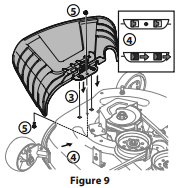
46”/50”/54”/60” Deck Models
1. The chute is shipped attached and with a stop bracket holding the chute upright. The stop brackets must be removed prior to operating the tractor.
2. Holding the chute deflector fully upward, remove the stop bracket. Lower the chute deflector and discard the stop bracket. See Figure 10.

Setting Front Gauge Wheels (If equipped)
Note: The deck wheels are an anti-scalp feature of the deck and are not designed to support the weight of the cutting deck.
1. Move the tractor to a level surface, preferably pavement.
2. Check tire pressure, adjust, if necessary. See tire side wall for proper tire pressure.
3. Make sure the deck is level side-to-side and properly pitched. See the Product Care section for deck leveling information and instructions.
4. Place deck lift lever or knob in the desired mowing height position.
5. Check the wheels for contact or excessive clearance with the surface below. Note: The deck wheels should have between ¼” (6.35mm) and ½” (12.7mm) clearance above the ground.
6. Remove the lock nut (a) gauge wheel (b) and shoulder screw (c) from the deck. See Figure 11.
7. Insert the shoulder screw into one of four index holes on front gauge wheel bracket. Allow a ⁄⁄” (6.35-12.7 mm) clearance between the ground and gauge wheel.
8. Note the index hole used on previously adjusted wheel. Repeat adjustment on opposite side to align both gauge wheels.
Note: Refer to Adjusting the Deck section of this manual for more detail.

Connecting Battery Cables
For shipping reasons the factory may leave both battery cables disconnected from the terminals. To connect the battery cables, proceed as follows:
1. If present, remove the plastic cover from the positive battery terminal. Attach the red connector to the positive battery terminal (+) using the bolt (a) and hex nut (b). See Figure 12.
2. If present, remove the plastic cover from the negative battery terminal and attach the black cable to the negative battery terminal (–) with the bolt (a) and hex nut (b). See Figure 12.
3. Position the red rubber boot (c) over the positive battery terminal to help protect it from corrosion. See Figure 12.
Note: If the battery is put into service after date shown on top/side of battery, charge the battery as instructed in the Product Care section, prior to operating.
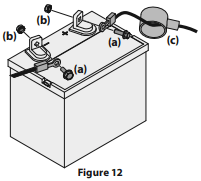
Battery Maintenance
- The battery is filled with battery acid and then sealed at the factory. However, even a “maintenance free” battery requires some maintenance to ensure its proper life cycle.
- Spray the terminals and exposed wire with a battery terminal sealer, or coat the terminals with a thin coat of grease or petroleum jelly, to protect against corrosion.
- Always keep the battery cables and terminals clean and free of corrosion.
- Avoid tipping. Even a sealed battery will leak electrolyte when tipped.
Battery Storage
- When storing the tractor for extended periods, disconnect the negative battery cable. It is not necessary to remove the battery.
- All batteries discharge during storage. Keep the exterior of the battery clean, especially the top. A dirty battery will discharge more rapidly.
- The battery must be stored with a full charge. A discharged battery can freeze sooner than a charged battery. A fully charged battery will store longer in cold temperatures than hot.
- Recharge the battery before returning to service. Although the tractor may start, the engine charging system may not fully recharge the battery.
Battery Removal
The battery is located beneath the seat frame. To remove the battery:
1. Remove the hex washer screw (a) securing the battery hold-down bracket (b) to the frame. Then flip the battery hold-down bracket (b) up to free the battery. See Figure 13.
2. Remove the hex cap screw and sems nut securing the black negative battery lead to the negative battery post (marked NEG). Move the cable away from the negative battery post.
3. Remove the hex cap screw and sems nut securing the red positive battery lead to the positive battery post (marked POS).
4. Carefully lift the battery out of the tractor.
5. Install the battery by repeating the above steps in the reverse order.
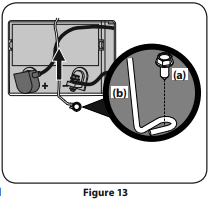
Charging the Battery
Test and, if necessary, recharge the battery after the tractor has been stored for a period of time.
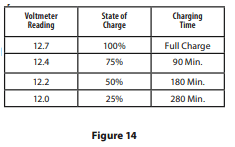
- A voltmeter or load tester should read 12.6 volts (DC) or higher across the battery terminals. See Figure 14.
- Charge the battery with a 12-volt battery charger at a MAXIMUM rate of 10 amps.
Adjusting the Seat Knob Adjust
1. Remove the knobs (a).
2. Slide the seat up or down into the desired position.
3. Replace the knobs into one of the four hole settings and tighten securely. See Figure 15.
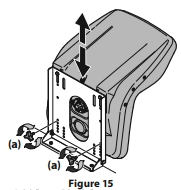
Lever Adjust
1. Push left and hold the seat adjustment lever to adjust the seat position.
2. Slide seat forward or rearward to desired position.
3. Release the adjustment lever. Ensure seat is locked into position before operation. See Figure 16.
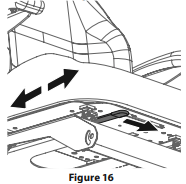
OPERATION
Note: This Operator’s Manual covers several models. Tractor features may vary by model. Not all features in this manual are applicable to all tractor models and the tractor depicted may differ from yours.
Note: References to LEFT, RIGHT, FRONT, and REAR indicate that position on the tractor when facing forward while seated in the operator’s seat.
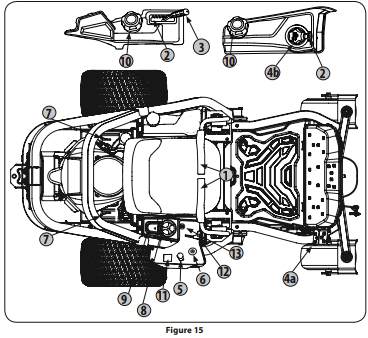
1 Lapbar Drive Control Levers
The RH (Right Hand) and LH (Left Hand) lapbar drive control levers are located on each side of the operator’s seat. The hinged levers pivot outward to permit the operator to sit in the seat, or dismount. To start the tractors engine, the lapbar drive control levers must be fully out and in park position. When the lapbar drive control levers are fully outward, the parking brake is engaged.
Each drive control lever controls the respective transmission. Consequently, these levers control all of the tractors movement. Driving and steering using these control levers is quite different from a conventional tractor and will take practice to master. Refer to Practice Operation section for further instructions.
2 Deck Height Index
If equipped with a deck lift handle: Each height index notch corresponds to approximately a 1⁄2” (12.7mm) change in deck height. See 3 in Figure 15.
If equipped with a deck lift pedal and knob: Each rotation represents a ⁄” (6.35 mm) change in deck height. Positions range from 1” (2.5 cm) to 4-½ ” (11.4 cm) at the highest point. See 4a and 4b in Figure 15.
3 Deck Lift Handle (If Equipped)
The deck lift handle is used to raise and lower the mower deck. To lower the deck, pull the deck lift handle to the right out of the index notch and push downward. To raise the deck, pull upward. Ensure handle is fully positioned into the height index notch when the desired height is attained.
4a Deck Lift Pedal (If Equipped)
The deck lift pedal is located on the front, right corner of the platform. The pedal is used in conjunction with the deck lift knob (if equipped) to raise and lower the mowing deck. Push forward on the deck lift pedal, rotate the deck lift knob to the desired height and release the deck lift pedal.
4b Deck Lift Knob (If Equipped)
The deck lift knob is used in conjunction with the deck lift pedal (if equipped) to raise and lower the mowing deck. Push forward on the deck lift pedal, rotate the deck lift knob to the desired height and release the deck lift pedal.
5 Power Take-Off (PTO)
Electric PTO (If equipped)
The PTO switch operates the electric PTO clutch mounted on the bottom of the engine crankshaft. Pull the switch knob upward to engage the PTO clutch, or push the knob downward to disengage the clutch.
The PTO switch must be in the “OFF” position when starting the engine.

6 Ignition Switch
The ignition switch has three positions:
STOP  — The engine and electrical system is turned off.
— The engine and electrical system is turned off.
RUN  — The riding mower electrical system is energized.
— The riding mower electrical system is energized.
START  — The starter motor will turn over the engine. Release the key immediately when the engine starts.
— The starter motor will turn over the engine. Release the key immediately when the engine starts.
Note: To prevent accidental starting and/or battery discharge, remove key from the ignition switch when tractor is not in use.
7 Transmission Bypass Rods
The transmission bypass rods (one for each RH and LH transmission) are located on the rear of the tractor, next to the engine.When engaged, the two rods open a bypass within the hydrostatic transmissions, which allows the tractor to be pushed short distances by hand. Refer to the Assembly section for additional instructions.
8 Cup Holder
The cup holder is located on the top of the console.
9 Storage Tray
The storage tray is located to the rear of the console.
10 Fuel Tank Cap
Turn the fill cap at least two clicks counter clockwise and pull upward to remove. The fuel cap is tethered to the tractor to prevent its loss. Do not attempt to remove the cap from the tractor. Fill tank to ½ ” (12.7 mm)below the bottom of the filler neck, allowing some space in the tank for fuel expansion. Do not overfill the tank.
Push the cap downward on the fuel tank fill neck and turn at least two clicks clockwise to tighten. Always re-install the fuel cap tightly onto the fuel tank after removing.
11 Hour Meter & LCD Service Minder (If equipped)
The LCD service minder will remind the operator of maintenance intervals for changing the engine oil, air filter service, low engine and low battery warnings. When the key is rotated out of the STOP position but is not in the START position, the LCD service minder & hour meter will briefly display the battery voltage, followed by the tractor’s accumulated hours.
Note: When the ignition key is out of the STOP position the hourglass  symbol is illuminated/blinks to indicate it is recording the hours of tractor operation, regardless of whether the engine has been started.
symbol is illuminated/blinks to indicate it is recording the hours of tractor operation, regardless of whether the engine has been started.
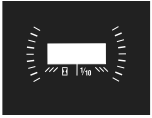
Change Oil
The LCD screen will alternate the letters “CHG”, followed by “OIL”, followed by “SOON”, followed by the meter’s accumulated time. “CHG/OIL/SOON/TIME” will alternate on the display for 7 minutes after the meter reaches 50 hours. This oil service minder interval will occur every 50 hours. Before the interval expires, change the engine oil as instructed in the Engine Operator’s Manual
Low Oil
Note: The low oil pressure function only works if the engine is equipped with an oil pressure switch.
The LCD screen will alternate the letters “LO” followed by “OIL”, followed by the meter’s accumulated time, which indicates the engine has low oil pressure. This is common when starting an engine. The indicator will remain active until the engine sufficiently builds pressure after starting. If it remains on with the engine at full speed and after a few minutes of operation, stop the tractor immediately and check the engine oil level and add as instructed in the Engine Operator’s Manual. If the oil level is correct and the indicator persists, contact an authorized service dealer.
Low Battery
At startup, the battery voltage will briefly display, then changes to accumulated hours. The letters “LO” followed by the letters “BATT” will display, followed by the meter’s accumulated time. “LO/BATT/TIME” is displayed on the LCD when the voltage drops below 11.5 volts. When this occurs, the battery is in need of a charge or the engine’s charging system is not generating sufficient amperage. Charge the battery as instructed in the Product Care section of this manual or have the charging system checked by your local service dealer.
Air Filter Service
The LCD screen will display the letters “CLN” followed by the letters “AIR”, followed by “FILT”, followed by the meter’s accumulated time. “CLN/AIR/FILT/TIME” will alternate on the display for 7 minutes after the meter reaches 25 hours. This air filter service minder time interval will be every 25 hours. On intervals that are common with oil service, the oil message will be displayed first followed by the air filter message.
12 Throttle/Choke Control Lever or Throttle Control Lever
Note: When set in a given position, a uniform engine speed will be maintained.
Throttle Control Lever (If equipped)
Push the throttle control lever forward to increase the engine speed. The tractor is designed to operate with the throttle control lever at full throttle (FAST) when the tractor is being driven and the tractor deck is engaged. Pull the throttle control lever rearward to decrease the engine speed.

Throttle/Choke Control Lever (If equipped)
Push the throttle/choke control lever forward to increase the engine speed. The tractor is designed to operate with the throttle/choke control lever at full throttle (FAST) when the tractor is being driven and the mower deck is engaged. Pull the throttle/choke control lever rearward to decrease the engine speed. When starting the engine, push the control lever fully forward into the “CHOKE” position. After starting and warming the engine, move the control handle rearward until you feel it move past the choke detent. Throttle is not meant to control unit speed, throttle should remain in high speed while operating blades.

13 Choke Control (If equipped)
The choke control determines the position of the engine choke. Pull the knob out to choke the engine; push the knob in to open the choke.

Multi-Tool (If equipped)
The multi-tool (a) is located on the front of the right console. The multi-tool (a) can be used as a deck lift lockout, to remove the footpan bolt, adjust the height of the lapbar drive control levers, drive control lever stop adjustment and can be used as a removal tool with the ½ ” socket end. See the Product Care section for more information on multi-tool (a) usage. See Figure 16.
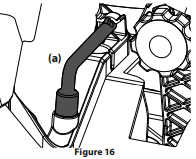
Headlights (Not shown/If equipped)
The headlights are located on the front of the frame. The headlights are ON whenever the ignition key is rotated out of the STOP position and OFF when the ignition key is moved to the STOP position.
Seat Adjustment Lever (Not shown/If equipped)
The seat adjustment lever is located under the seat. The seat adjustment lever allows for adjustment forward or backward of the operator’s seat. Refer to the Assembly & Set-Up section for instructions on adjusting the seat position.
Note: If your tractor is not equipped with a seat adjustment lever, it can be adjusted using the knobs on the underside of the seat. Refer to the Assembly & Set-Up section for instruction on adjusting the seat.
OPERATION
Operation
Before Operating Your Tractor
- Before operation, refer to Maintenance Schedule chart located in this manual for regularly scheduled service items.
- This engine is certified to operate only on clean, fresh, unleaded gasoline. Fill only with clean, fresh, unleaded gasoline with a pump sticker octane rating of 87 or higher.
- Do not use gasoline left over from the previous season, to minimize gum deposits in the fuel system.
- Gasohol (up to 10% ethyl alcohol, 90% unleaded gasoline by volume) is an approved fuel. Other gasoline/alcohol blends are not approved.
- Methyl Tertiary Butyl Ether (MTBE) and unleaded gasoline blends (up to a maximum of 15% MTBE by volume) are approved fuels. Other gasoline/ether blends are not approved.
Starting the Engine
1. Operator should be sitting in the tractor seat with the lapbar drive control levers fully out and in the park position. See Figure 17. Refer to Practice Operation for further instructions.
2. Make certain the PTO is in the “OFF” position. Move the choke control or throttle/choke control into the full choke position. Move the throttle control to midway between its slow and fast positions on models with a separate choke control. Note: If the engine is warmed up, it may not be necessary to choke the engine.
3. Turn the key clockwise to the START position. After the engine starts, release the key. It will return to the RUN position.
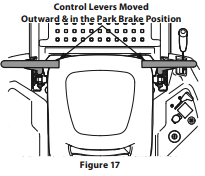
4. As the engine warms up, gradually pull the throttle/choke control lever rearward past the choke detent position or slowly disengage the choke on models with a separate choke. Do not use the choke position to enrich the fuel mixture, except as necessary to start the engine.
5. Allow the engine to run for a few minutes at mid-throttle before putting the engine under load.
6. Observe the hour meter/indicator panel. If the battery indicator light or oil pressure light come on, immediately stop the engine. Have the tractor inspected by your authorized service dealer.
Cold Weather Starting
When starting the engine at temperatures near or below freezing, ensure the correct viscosity motor oil is used in the engine and the battery is fully charged. Start the engine as follows:
1. Be sure the battery is in good condition. A warm battery has much more starting capacity than a cold battery.
2. Use fresh winter grade fuel. Winter grade gasoline has higher volatility to improve starting. Do not use gasoline left over from summer.
3. Follow the previous instruction for Starting the Engine.
Using Jumper Cables To Start Engine
If the battery charge is not sufficient to crank the engine, recharge the battery. If a battery charger is unavailable and the tractor must be started, the aid of a booster battery will be necessary. Connect the booster battery as follows:
1. Connect the end of one cable to the disabled tractor battery’s positive terminal; then connect the other end of that cable to the booster battery’s positive terminal.
2. Connect one end of the other cable to the booster battery’s negative terminal; then connect the other end of that cable to the frame of the disabled tractor, as far from the battery as possible.
3. Start the disabled tractor following the normal starting instructions previously provided; then disconnect the jumper cables in the exact reverse order of their connection.
4. Have the tractor’s electrical system checked and repaired as soon as possible to eliminate the need for jump starting.
Stopping the Engine
1. Disengage the PTO.
2. Move the RH and LH lapbar drive control levers fully outward into the Park Brake engaged position.
3. Move the throttle control to midway between the slow and fast positions.
4. Turn the key to the STOP position and remove the key from the ignition module. Note: Always remove the key from the ignition module to prevent accidental starting or battery discharge if the equipment is left unattended.
Practice Operation (Initial Use)
Operating a zero-turn tractor is not like operating a conventional type riding tractor. Although and because a zero turn tractor is more maneuverable, getting used to operating the lapbar drive control levers takes some practice.
It is strongly recommended that you locate a reasonably large, level and open “practice area” where there are no obstructions, pedestrians, or animals. You should practice operating the tractor for a minimum of 30 minutes.
Carefully move (or have moved) the tractor to the practice area. When performing the practice session, the PTO should not be engaged. While practicing, operate the tractor at approximately ⁄-⁄ throttle and at less than full speed in both forward and reverse.
Carefully practice maneuvering the tractor using the instructions in the following section “Driving the Tractor.” Practice until you are confident that you can safely operate the tractor.
Driving the Tractor
1. Adjust the operator’s seat to the most comfortable position that allows you to operate the controls. See seat adjustment in the Assembly & Set-Up section.
2. Move the RH and LH lapbar drive control levers inward in the neutral position which also disengages the parking brake. Refer to Figure 18. Note: Lapbar drive control levers must be moved fully inward before pushing forward or backward to ensure brakes are fully disengaged. Parking the tractor on uneven terrain or a hill may cause the brakes to bind and not release fully. In this case the tractor will not drive when the lapbar drive control levers are moved. If this happens, move the lapbar drive control lever in the opposite direction slightly to take the load off the brakes and allow them to release fully. Note: If the lap bar drive control levers are not even in the neutral position, refer to Maintenance & Adjustments for instructions to adjust the lapbar drive control levers so that they are even.
3. Move the throttle to the full throttle position.
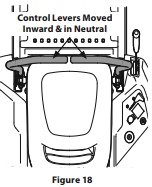
4. To drive the tractor, firmly grasp the respective lapbar drive control levers with your right and left hands and continue with Driving the Tractor Forward in the next section.
Driving the Tractor Forward
1. Slowly and evenly move both lapbar drive control levers forward. The tractor will start to move forward. See Figure 19.
2. As the lapbar drive control levers are pushed farther forward the speed of the tractor will increase.
3. To slow the tractor move the drive controls lever rearward to attain the desired speed, or move the lapbar drive control levers to the neutral position to stop the tractor.
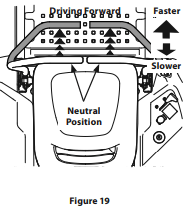
Turning the Tractor While Driving Forward
To turn the tractor while driving forward, move the lapbar drive control levers as necessary so that one drive control lever is rearward of the other. The tractor will turn in the direction of the rearward drive control lever.
1. To turn to the left, move the left drive control lever rearward of the right drive control lever. See Figure 20.
2. To turn to the right, move the right drive control lever rearward of the left lever. See Figure 21.
3. The greater the distance between the two levers, the sharper the tractor will turn.
4. To execute a “pivot turn,” move the turn side drive control lever to the neutral position, while moving the other control lever forward.
Note: Making a “pivot turn” on grass will greatly increase the potential for defacement of the turf.
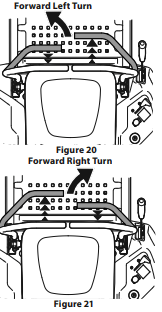
Mowing
Note: Do not engage the mower deck when lowered in grass. Premature wear and possible failure of the ‘V” belt and PTO clutch will result. Fully raise the deck or move to a non grassy area before engaging the mower deck.
- Mow across slopes, not up and down. If mowing a slope, start at bottom and work upward to ensure turns are made uphill.
- Do not mow at high ground speed, especially if a mulch kit or grass collector is installed.
- Do not cut the grass too short. Short grass is prone to weed growth and yellows quickly in dry weather.
- Always operate the tractor with the throttle in the FAST position while mowing.
- On the first pass pick a point on the opposite side of the area to be mowed. Follow the point to maintain a straight line
- Engage the PTO and move the throttle control or throttle/choke control to the FAST position.
- Lower the mower deck to the desired height setting.
- For best results it is recommended that the first two laps be cut with the discharge thrown towards the center. After the first two laps, reverse the direction to throw the discharge to the outside for the balance of cutting. This will give a better appearance to the lawn.
- Slowly and evenly push the RH and LH lapbar drive control levers forward to move the tractor forward, and keep the tractor headed directly toward the alignment point. Note: The speed of the tractor will affect the quality of the mower cut. Mowing at full speed will adversely affect the cut quality. Control the ground speed with the lapbar drive control levers.
- Your tractor is designed to cut normal residential grass of a height no more than 10” (25cm). Do not attempt to mow through unusually tall, dry grass (e.g., pasture) or piles of dry leaves. Dry grass or leaves may contact the engine exhaust and/or build up on the tractor.
- Do NOT attempt to mow heavy brush and weeds or extremely tall grass. Your tractor is designed to mow lawns, NOT clear brush.
- Keep the blades sharp and replace the blades when worn.
- When approaching the other end of the strip, slow down or stop before turning. A U-turn is recommended unless a pivot or zero turn is required.
- Align the mower with an edge of the mowed strip and overlap approximately 3” (7.6 cm).
- Direct the tractor on each subsequent strip to align with a previously cut strip.
- To prevent rutting or grooving of the turf, if possible, change the direction that the strips are mowed by approximately 45° for the next and each subsequent mowing.
When stopping the tractor for any reason while on a grass surface, always:
- Move the RH and LH lapbar drive control levers fully outward into the Park Brake engaged position.
- Shut engine off and remove the key.
- Doing so will minimize the possibility of having your lawn ‘‘browned’’ by hot exhaust from your tractor’s running engine.
SERVICE AND MAINTENANCE
Cleaning the Underside of the Deck
Deck Wash System
Your tractor’s deck is equipped with a water port on its surface as part of its deck wash system.
wash system. Use the deck wash system to rinse grass clippings from the deck’s underside and prevent the buildup of corrosive chemicals. Complete the following steps AFTER EACH MOWING:
1. Attach the nozzle adapter to a standard garden hose connected to a water supply.
2. Move the tractor to an area within reach of the hose where the dispersal of wet grass clippings is acceptable. Disengage the PTO, engage the parking brake and stop the engine.
3. Pull back the lock collar (a) of the nozzle adapter (b) and push the nozzle adapter onto the deck wash nozzle (c). Release the lock collar to lock the nozzle adapter on the deck wash nozzle. See Figure 27.
4. Turn on the water supply.
5. From the tractor operator’s seat, start the engine and engage the PTO. Allow to run as needed. Disengage the PTO and stop the engine.
6. Turn off the water supply.
7. Pull back the lock collar of the nozzle adapter to disconnect the nozzle adapter from the deck wash nozzle.
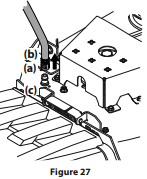
Cleaning the Tractor
Your tractor should be cleaned after each use and under certain conditions, i.e. dry conditions and/or mulching situations, additional cleaning may be necessary.
One of the best ways to keep your tractor running efficiently and to reduce fire risk is to regularly remove debris buildup from the tractor. Follow the recommendations below and contact your authorized dealer with any questions.
- Allow the machine to cool for at leasr five minutes in an open area before cleaning.
Note: Using a pressure washer or garden hose is not recommended for cleaning your tractor other than to clean the underside of the deck. It may cause damage to electrical components, spindles, pulleys, bearings or the engine. The use of water will result in shortened life and reduce serviceability.
- Keep both sides of transmission cooling slots, exhaust manifold, around fuses, all wiring and harnesses, muffler pipe, muffler shield, engine intake screens and cooling fins, etc clear of grass clippings and leaves. See Figure 28.
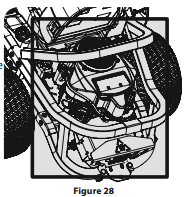
- Clean the top of the mower deck, under the spindle covers and belt area. See Figure 29.

- Clean around and near the transmission, axle and the fan area. See 30.

- Debris can accumulate anywhere on the tractor, especially on horizontal surfaces. Additional cleaning may be necessary when mowing in dry conditions or when mulching.
- Fuel leaks/spills, oil leaks/spills and excess lubrication can also become collections sites for debris. Immediate repair and cleaning up oil or fuel spills can help reduce fire hazards.
- In addition to cleaning the tractor before operating and storing, do not attempt to mow unusually tall grass (10” (25.4 cm) or higher), dry grass (e.g., pasture) or piles of dry leaves. Dry grass or leaves may contact the engine exhaust and/or build up on the mower deck presenting a potential fire hazard.
Storing the Tractor
- Allow the machine to cool in an open area for at least five minutes before storing.
- Do not park the tractor near any flammable materials (wood, cloth or chemicals) or any open flames or other potential source of ignition (furnace, water heater or any other type of heater).
- Remove all combustible materials from the tractor before storing. Empty cargo boxes, grass catchers or containers.
- Always shut off fuel flow when storing or transporting if tractor is equipped with a fuel shutoff.
- Check the fuel system (lines, tank, cap and fittings) per the maintenance schedule for cracks or leaks. Repair and clean as necessary.
Maintenance
Removing the Floor Panel (If equipped)
On some models, the floor panel can be removed for maintenance, service and cleaning. To remove the floor panel:
1. 1. Using the multi-tool (if equipped) or a 1/2” socket, remove the hex screw (a) that secures the floor panel in place. See 1 in Figure 31.1.
2. Carefully lift the rear of the floor panel. See 2 in Figure 31.
3. Slide the floor panel rearward to free the front of the floor panel. See 3 in Figure 31.
4. Lift it off the tractor. See 4 in Figure 31.
5. To place the floor panel back on the tractor, carefully put the floor panel back in place and reinstall the hex screw removed in step 1. 1. Using the multi-tool (if equipped) or a 1/2” socket, remove the hex screw (a) that secures the floor panel in place. See 1 in Figure 31.1. Torque to 108-132 in-lbs (12-15 N-m).
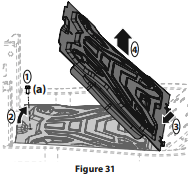
Changing the Engine Oil
Note: The oil filter should be changed at every oil change interval.
To complete an oil change, proceed as follows:
1. Locate the oil drain hose (a) on the side of the engine.
2. Place an appropriate oil collection container with at least a 2.5 quart (2.37 liter) capacity below the opening of the oil drain hose, to collect the used oil. Remove the oil fill cap/dipstick (b) from the oil fill tube.
3. While holding the free end of the oil drain hose over the oil collection container, unscrew the square head hose plug (c) from the end of the oil drain hose. See Figure 32. Drain the engine oil into the collection container.
4. After draining the oil, wipe any residual oil from the oil drain hose. Thread the square head hose plug into the oil drain hose fitting and tighten the square head hose plug to 16 ft.-lbs. (22 N-m).
5. Remove the oil filter (d) and drain into the collection container.
6. Replace the oil filter (d), and refill the engine with new oil as instructed in the Engine Operator’s Manual. Note: Place an absorbent towel beneath the oil filter to keep oil off the clutch. Note: Observe proper disposal laws and regulations for gas, oil, etc. to protect the environment. Note: Maintenance, repair, or replacement of the emission control devices and systems which are being done at owner’s expense may be performed by any engine repair establishment or individual. Warranty repairs must be performed by an authorized dealer.
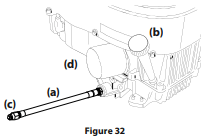
Adjustments
Deck Leveling
If the cutting deck appears to be mowing unevenly, leveling adjustments can be performed.
Leveling the Deck (Side-to-Side)
1. Place the deck lift handle or deck lift knob in a middle mowing position and rotate both outside blades so that they are perpendicular with the tractor.
2. Measure the distance from the outside of the left blade tip to the ground and the distance from the outside of the right blade tip to the ground. Both measurements taken should be equal. If they’re not, proceed to the next step.
3. Locate the adjustment bolts (a) on the left and right side of the deck. See 3. Locate the adjustment bolts (a) on the left and right side of the deck. See 3. Locate the adjustment bolts (a) on the left and right side of the deck. See Figure 35.5.
4. Loosen, but do not remove, the jam nuts (b) on the adjustment bolt. Adjust either the right or left adjustment bolt up or down as necessary until the side-to-side heights are equal. See 3. Locate the adjustment bolts (a) on the left and right side of the deck. See 3. Locate the adjustment bolts (a) on the left and right side of the deck. See Figure 35. Note: Continue to check the front-to-back leveling as you make the side-toside adjustment as the side-to-side adjustment can affect the front-to-back level. If necessary, adjust front-to-back as instructed previously.
5. When proper adjustment is achieved, re-tighten the jam nuts (b). Tighten to 57 ft-lbs (77.3 N-m).
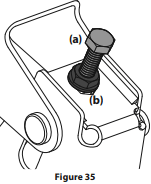
Leveling the Deck (Pitch/Front-to-Rear)
The front of the deck should be between 1⁄16 - 1⁄4” (2-6 mm) lower than the rear of the deck. Adjust if necessary as follows:
1. Park the tractor on a firm, level surface and place the deck lift handle or deck lift knob in a middle position.
2. Rotate the blade nearest the discharge chute so that it is parallel with the tractor.
3. Measure the distance from the front of the blade tip to the ground and the rear of the blade tip to the ground. The first measurement taken should be between 1⁄16 - 1⁄4” (2-6 mm) less than the second measurement.
4. Determine the approximate distance necessary for proper adjustment and proceed, if necessary.
5. To raise the front of the deck, remove the end cap, loosen the outer jam nut (a) then tighten (thread inward) the inner nut (b) against the front hanger bracket. See Figure 36. When proper adjustment is achieved, re-tighten the outer jam nut (a) and replace the end cap.
6. To lower the front of the deck, remove the end cap, loosen the outer jam nut (a) then loosen (thread outward) the inner nut (b), away from the front hanger bracket. See Figure 36. When proper adjustment is achieved, re-tighten the outer jam nut (a) to 57 ft-lbs. (77.28 N-m)and replace the end cap.
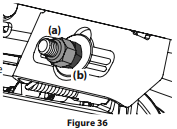
Adjusting the Deck Wheels
Note: The deck wheels are an anti-scalp feature of the deck and are not designed to support the weight of the cutting deck. The deck wheels should be approximately ⁄⁄” (6.35-12.7 mm)above the ground when the deck is set in the desired height setting. To adjust the deck wheels see the Assembly & Set-Up section for instructions.
Lapbar Drive Control Lever Stop Adjustment
When the lapbar drive control levers are both fully extended forward to the full-speed position and the tractor drifts left or right, the lapbar drive control lever stop adjustment can be adjusted to sync the wheel speeds. To perform the adjustment, proceed as follows:
1. Identify the side that the tractor is drifting to and adjust the opposite lapbar drive control lever. If the tractor drifts right, adjust the left lapbar drive control lever down (decrease speed) and vice versa.
2. Locate the lapbar drive control lever stop adjustment bolts (a) on the front of the seat frame. See 2. Locate the lapbar drive control lever stop adjustment bolts (a) on the front of the seat frame. See Figure 37. Note: The multi-tool (if equipped) can be used to make this adjustment.
3. To decrease the forward speed, turn the lapbar drive control lever stop adjustment bolts (a)clockwise. To increase the forward speed, turn the lapbar drive control lever stop adjustment bolts (a) counter-clockwise. Turn the lapbar drive control lever stop adjustment bolts (a) in the necessary direction 1⁄4 -turn at a time. After turning the lapbar drive control lever stop adjustment bolts (a), check the adjustment by driving the tractor.
4. Continue the adjustment until the wheel speeds are in sync and the tractor drives straight with the drive control levers fully extended forward in the full-speed position. Note: Make sure the bolts extend through the nuts on the frame to engage the locking feature.
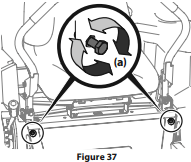
Tractor Blade Care
The cutting blades must be kept sharp at all times. Sharpen the cutting edges of the blades evenly so that the blades remain balanced and the same angle of sharpness is maintained.
If the cutting edge of a blade has already been sharpened many times, or if any metal separation is present, it is recommended that new blades be installed. New blades are available at your authorized dealer.
The blades may be removed as follows.
1. Remove the deck from beneath the tractor, (refer to Deck Removal) then gently flip the deck over to expose its underside.
2. Use a 15⁄16” wrench to hold the hex nut on top of the spindle assembly when loosening the hex nut (a) securing the blade (b). A block of wood (c) may be placed between the deck housing and the cutting edge of the blade (b) to help in breaking loose the hex nut (a) securing the blade. See Figure 46.
3. When reinstalling the blades, be sure they are installed so that the wings are pointing upward toward the top of the deck.
4. Tighten the hex nuts (a) to 70-90 ft. lbs. (95-122 N-m).
5. Reinstall the deck (refer to Deck Installation).
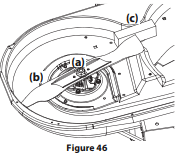
Changing the Transmission Drive Belt
Several components must be removed and special tools used in order to change the tractor’s transmission drive belt. See your authorized service dealer to have the transmission drive belt replaced.
Tractor Creeping
Creeping is the slight forward or backward movement of the tractor when the throttle is on and the speed control levers are in the neutral position. If your tractor creeps, see an authorized service dealer.
TROUBLESHOOTING
Engine Fails to start
1. PTO/Blade Engage knob engaged.
- Place knob in disengaged (OFF) position.
2. Parking brake not engaged.
- Engage parking brake.
3. Spark plug wire disconnected.
- Connect wire to spark plug.
4. Throttle control lever not in correct starting position.
- Place Throttle lever to FAST position.
5. Fuel tank empty, or stale fuel.
- Fill tank with clean, fresh (less than 30 days old) gas.
6. Blocked fuel line or fuel filter.
- Replace fuel line. See a Sears or other qualified service dealer. Replace fuel filter. See the Service and Maintenance section.
7. Faulty spark plug.
- Clean, adjust gap or replace plug.
8. Engine flooded.
- Crank engine with throttle in FAST position.
9. Fuse(s) blown.
- Replace fuse.
Engine runs erratically
1. Riding mower running with Choke activated.
- Check that the electric choke is working. See a Sears or other qualified service dealer.
2. Spark plug wire loose.
- Connect and tighten spark plug wire.
3. Blocked fuel line or stale fuel.
- Replace fuel line. See a Sears or other qualified service dealer. Fill tank with clean, fresh gasoline and replace fuel filter. See the Service and Maintenance section.
4. Vent in gas cap plugged.
- Clear vent or replace cap if damaged.
5. Water or dirt in fuel system.
- Drain fuel tank. Refill with clean, fresh gasoline. See the Service and Maintenance section.
6. Dirty air cleaner.
- Clean or replace air cleaner paper element or clean foam pre-cleaner.
Engine overheats
1. Engine oil level low
- Fill engine with proper amount and type of oil.
2. Air flow restricted
- Clean grass clippings and debris from around the engine’s cooling fins and blower housing.
Engine hesitates at high RPMs
1. Spark plug gap set too close
- Remove spark plug and adjust gap.
Engine idles poorly
1. Fouled spark plug
- Replace spark plug and adjust gap.
2. Dirty air cleaner
- Clean or replace air cleaner element and/or clean pre-cleaner.
Excessive vibration
1. Cutting blades loose or unbalanced
- Tighten blade and spindle. Balance blade.
2. Damaged, dull, or bent cutting blade
- Replace blade.
Uneven cut
1. Deck not leveled properly.
- Perform side-to-side deck adjustment.
2. Dull blade.
- Sharpen or replace blade.
3. Uneven tire pressure.
- Check tire pressure in all four tires.
See other models: CMXGNAM1130054 CMXGNAM1130046 CMXGRAM7821291 CMXGRAM1130040 CMXGRAM1130049

